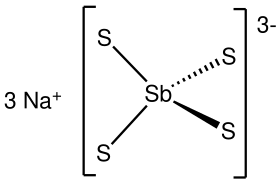
| |
| Names | |
|---|---|
| IUPAC name
Sodium tetrathioantimonate(V)
| |
| Identifiers | |
| |
3D model (JSmol)
|
|
| ChemSpider |
|
| ECHA InfoCard | 100.208.207 |
| EC Number |
|
PubChem CID
|
|
| UNII |
|
CompTox Dashboard (EPA)
|
|
| |
| |
| Properties | |
| Na3SbS4 (anhydrous) Na3SbS4·9H2O (nonahydrate) | |
| Molar mass | 272.13 g·mol−1 (anhydrous) 434.27 g·mol−1 (nonahydrate) |
| Appearance | Yellow crystals |
| Density | 1.806 g/cm3, solid |
| Melting point | 87 °C (189 °F; 360 K) |
| Hazards | |
| GHS labelling: | |
 
| |
| Warning | |
| H302, H332, H411 | |
| P261, P264, P270, P271, P273, P301+P312, P304+P312, P304+P340, P312, P330, P391, P501 | |
| Related compounds | |
Other cations
|
Potassium thioantimoniate |
Related compounds
|
Antimony(III) sulfide |
Except where otherwise noted, data are given for materials in their standard state (at 25 °C [77 °F], 100 kPa).
| |
Sodium thioantimoniate or sodium tetrathioantimonate(V) is an inorganic compound with the formula Na3SbS4. The nonahydrate of this chemical, Na3SbS4·9H2O, is known as Schlippe's salt, named after Johann Karl Friedrich von Schlippe (1799–1867). These compounds are examples of sulfosalts. They were once of interest as species generated in qualitative inorganic analysis.
Structure

The nonahydrate consists of the tetrahedral tetrathioantimonate(V) anions SbS3−4 and sodium cations Na+, which are hydrated. The Sb-S distance is 2.33 Å.[1][2] Related salts are known for different cations including ammonium and potassium.
The anhydrous salt is a polymer with tetrahedral Na and Sb sites.[3]
Preparation
Sodium tetrathioantimonate nonahydrate is prepared by the reaction of "antimony trisulfide", elemental sulfur, and aqueous sulfide source.[4]
- 3 Na2S + 2 S + Sb2S3 + 18 H2O → 2 Na3SbS4·9H2O
The Na2S can be generated in situ by the reaction of sodium hydroxide and S (co-generating sodium sulfate):
- Sb2S3 + 8 NaOH + 6 S → 2 Na3SbS4 + Na2SO4 + 4 H2O
Charcoal can also be used to reduce the sulfur.
The required antimony trisulfide is prepared by treatment of Sb(III) compounds with sulfide sources:
- 2 SbCl3 + 3 H2S → Sb2S3 + 6 HCl
Reactions
The hydrate dissolves in water to give the tetrahedral SbS3−4 ion. The salt gives antimony pentasulfide upon acidification:
- 2 Na3SbS4 + 6 HCl → Sb2S5 + 6 NaCl + 3 H2S
Notes
- ^ Krebs, B., "Thio- and Seleno Compounds of Main Group Elements - New Inorganic Oligomers and Polymers", Angewandte Chemie, 1983, volume 95, pages 113-34.
- ^ K. Mereiter, A. Preisinger and H. Guth "Hydrogen bonds in Schlippe's salt: refinement of the crystal structures of Na3SbS4.9H2O by X-ray diffraction and Na3SbS4.9D2O by neutron diffraction at room temperature" Acta Crystallographica 1979, vol. B35, 19-25. doi:10.1107/S0567740879002442.
- ^ H. A. Graf, H. Schäfer "Zur Strukturchemie der Alkalisalze der Tetrathiosäuren der Elemente der 5. Hauptgruppe (pages 67–80) Zeitschrift für Anorganische und Allgemeine Chemie 1976, vol. 425, p67-p80. doi:10.1002/zaac.19764250109
- ^ P. W. Schenk (1963). "Arsenic, Antimony, Bismuth". In G. Brauer (ed.). Handbook of Preparative Inorganic Chemistry, 2nd Ed. Vol. 1pages=618. NY, NY: Academic Press.
References
- This article incorporates text from a publication now in the public domain: Chisholm, Hugh, ed. (1911). "Schlippe's Salt". Encyclopædia Britannica (11th ed.). Cambridge University Press.
